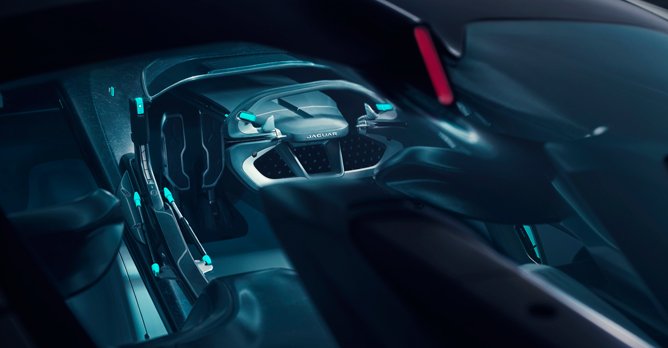The Jaguar Vision Gran Turismo SV, the ultimate electric gaming endurance racer
22 Dec 2020|972 views
A maximum speed of 410km/h, an aerodynamic design honed to perfection and race-winning powertrain technology define the Jaguar Vision Gran Turismo SV - the latest all electric virtual race car developed for Gran Turismo, and built in the real-world as full-scale design study.
The Jaguar Vision Gran Turismo Coupe - the first all electric Jaguar sports car created for the globally-renowned Gran Turismo series revealed in October 2019 - has already proved highly successful, attracting gamers with its radical, heritage-inspired design, driver-focused interior, and outstanding ride and handling.
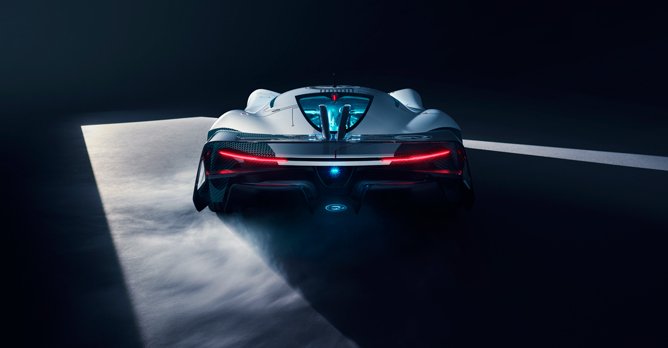
Fundamental to that process was detailed analysis of gamer feedback from online videos and forums. This 'virtual world testing' combined with many hours 'behind the wheel' enabled the design and engineering teams to determine exactly how to optimise the Vision GT SV to create the perfect electric gaming endurance race car.
The streamlined, lightweight composite body structure now houses four motors, generating a combined output of 1,877bhp and 3,360Nm of torque with the traction and dynamics benefits of intelligent all-wheel drive and torque vectoring. Acceleration from 0-96km/h takes just 1.65 seconds, on the way to a maximum speed of 410km/h.
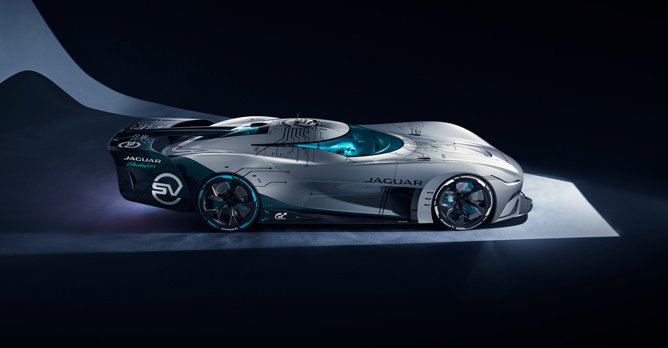
Measuring 5,540mm from nose to tail, the GT SV is 861mm longer overall - a change driven entirely by aerodynamics. To deliver the increased downforce needed for greater traction for faster cornering and increased high speed stability on long straights, the GT SV has a new front splitter and a new deployable rear wing.
To solve the often conflicting requirements of increasing downforce while also minimising drag, the SV team worked with Jaguar's designers to develop a full suite of features which work together to improve dynamics, stability, performance and efficiency.
In addition to the larger, more effective splitter - which produces downforce over the front axle - apertures in the front valance channel air across the face of the front wheels to reduce turbulence and help air to flow cleanly towards the rear of the car. Air passing through the wheel wells is also smoothed towards the rear via exit vents in the fenders.
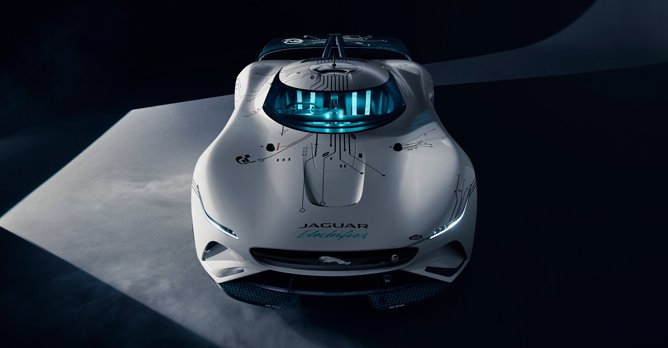
The single most effective aero feature developed for the GT SV is its deployable rear wing, inspired by endurance racing cars from Jaguar's rich lineage, including the XJR-14. Meticulously developed from concept to final design through many iterations, the wing's main, fixed, section wraps over and around the back of the car, blending smoothly into the rear haunches.
The wing is designed as an integral element of the sculpted bodywork while also providing the aerodynamic performance required for endurance racing, two moveable sections automatically rise at speed to deliver extra downforce when needed but drop back to their nominal positions to minimise drag.
As a result, the GT SV has a drag coefficient of 0.398Cd - remarkably low for a race car - but also generates 483kg of downforce at 322km/h.
Jaguar Racing engineers developed the GT SV's extraordinary quad-motor all electric propulsion system. They also designed the system for the first Jaguar Vision GT car, applying all of their knowledge and experience from developing the Jaguar I-TYPE over six successive seasons.
The work was split into two main projects. A second 401bhp motor to the front axle to deliver the higher power and torque ratings required. Then the thermal management system was further improved to cope with the higher loads and to ensure that sustained high speeds and extreme acceleration could be maintained throughout an endurance race.
With one motor driving each wheel, the GT SV's propulsion system generates a combined output of 1,877bhp and 3,360Nm torque. Each motor has its own single-speed transmission. As well as electric all-wheel drive, the one motor per wheel configuration also enables infinite control of lateral and longitudinal torque distribution, delivering a step-change in torque vectoring capability for even greater traction, agility, and control.
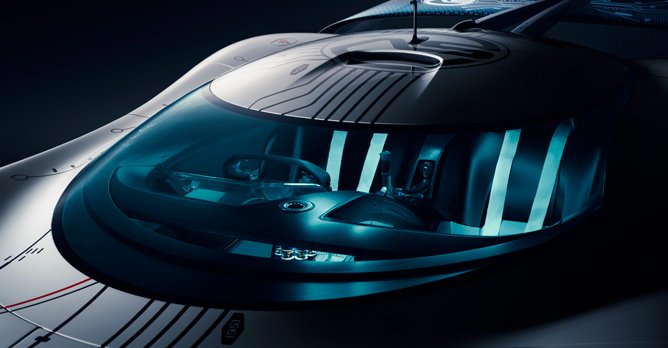
Reflecting the increase in power and torque from the four electric motors, the GT SV generates a sound that is even more purposeful and distinctive, and is authentically yet futuristically Jaguar.
The experience is heightened by an interior designed for racing. The pure, sweeping surfaces within the cockpit truly envelop the driver and position the instruments and perfectly weighted controls exactly where they need to be. Every component is beautifully crafted with absolute precision from advanced lightweight materials, including the new TYPEFIBRE fabrics used to cover the two sculpted composite seats.
A maximum speed of 410km/h, an aerodynamic design honed to perfection and race-winning powertrain technology define the Jaguar Vision Gran Turismo SV - the latest all electric virtual race car developed for Gran Turismo, and built in the real-world as full-scale design study.
The Jaguar Vision Gran Turismo Coupe - the first all electric Jaguar sports car created for the globally-renowned Gran Turismo series revealed in October 2019 - has already proved highly successful, attracting gamers with its radical, heritage-inspired design, driver-focused interior, and outstanding ride and handling.

Fundamental to that process was detailed analysis of gamer feedback from online videos and forums. This 'virtual world testing' combined with many hours 'behind the wheel' enabled the design and engineering teams to determine exactly how to optimise the Vision GT SV to create the perfect electric gaming endurance race car.
The streamlined, lightweight composite body structure now houses four motors, generating a combined output of 1,877bhp and 3,360Nm of torque with the traction and dynamics benefits of intelligent all-wheel drive and torque vectoring. Acceleration from 0-96km/h takes just 1.65 seconds, on the way to a maximum speed of 410km/h.

Measuring 5,540mm from nose to tail, the GT SV is 861mm longer overall - a change driven entirely by aerodynamics. To deliver the increased downforce needed for greater traction for faster cornering and increased high speed stability on long straights, the GT SV has a new front splitter and a new deployable rear wing.
To solve the often conflicting requirements of increasing downforce while also minimising drag, the SV team worked with Jaguar's designers to develop a full suite of features which work together to improve dynamics, stability, performance and efficiency.
In addition to the larger, more effective splitter - which produces downforce over the front axle - apertures in the front valance channel air across the face of the front wheels to reduce turbulence and help air to flow cleanly towards the rear of the car. Air passing through the wheel wells is also smoothed towards the rear via exit vents in the fenders.

The single most effective aero feature developed for the GT SV is its deployable rear wing, inspired by endurance racing cars from Jaguar's rich lineage, including the XJR-14. Meticulously developed from concept to final design through many iterations, the wing's main, fixed, section wraps over and around the back of the car, blending smoothly into the rear haunches.
The wing is designed as an integral element of the sculpted bodywork while also providing the aerodynamic performance required for endurance racing, two moveable sections automatically rise at speed to deliver extra downforce when needed but drop back to their nominal positions to minimise drag.
As a result, the GT SV has a drag coefficient of 0.398Cd - remarkably low for a race car - but also generates 483kg of downforce at 322km/h.
Jaguar Racing engineers developed the GT SV's extraordinary quad-motor all electric propulsion system. They also designed the system for the first Jaguar Vision GT car, applying all of their knowledge and experience from developing the Jaguar I-TYPE over six successive seasons.
The work was split into two main projects. A second 401bhp motor to the front axle to deliver the higher power and torque ratings required. Then the thermal management system was further improved to cope with the higher loads and to ensure that sustained high speeds and extreme acceleration could be maintained throughout an endurance race.
With one motor driving each wheel, the GT SV's propulsion system generates a combined output of 1,877bhp and 3,360Nm torque. Each motor has its own single-speed transmission. As well as electric all-wheel drive, the one motor per wheel configuration also enables infinite control of lateral and longitudinal torque distribution, delivering a step-change in torque vectoring capability for even greater traction, agility, and control.

Reflecting the increase in power and torque from the four electric motors, the GT SV generates a sound that is even more purposeful and distinctive, and is authentically yet futuristically Jaguar.
The experience is heightened by an interior designed for racing. The pure, sweeping surfaces within the cockpit truly envelop the driver and position the instruments and perfectly weighted controls exactly where they need to be. Every component is beautifully crafted with absolute precision from advanced lightweight materials, including the new TYPEFIBRE fabrics used to cover the two sculpted composite seats.
Latest COE Prices
June 2025 | 1st BIDDING
NEXT TENDER: 18 Jun 2025
CAT A$96,999
CAT B$113,000
CAT C$62,000
CAT E$113,900
View Full Results Thank You For Your Subscription.










